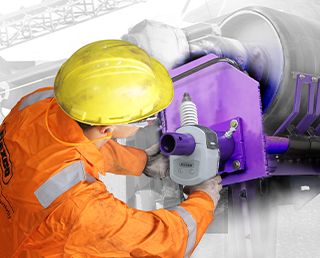Elevate Your Maintenance Strategy: Reactive vs. Proactive vs. Predictive Maintenance
 One of the greatest threats and concerns of a mining operation is a belt conveyor failure or unexpected downtime. Considering the effects of either event can range from costly to catastrophic, it would stand to reason that operations would do everything in their power to avoid them from occurring. The best defense to these occurrences is an effective maintenance strategy for belt cleaners, a key component of conveyor performance. To better understand how to optimize this strategy, it is important to distinguish the differences between reactive maintenance, proactive maintenance, and predictive maintenance.
One of the greatest threats and concerns of a mining operation is a belt conveyor failure or unexpected downtime. Considering the effects of either event can range from costly to catastrophic, it would stand to reason that operations would do everything in their power to avoid them from occurring. The best defense to these occurrences is an effective maintenance strategy for belt cleaners, a key component of conveyor performance. To better understand how to optimize this strategy, it is important to distinguish the differences between reactive maintenance, proactive maintenance, and predictive maintenance.
Reactive maintenance is the least efficient approach to belt cleaners, and bulk material handling operations in general. As the name implies, this strategy is built around making repairs or replacements only after a problem has occurred. At the very least, this approach can be quite disruptive and costly to an operation as it requires unplanned downtime to make repairs. Perhaps more concerning is the potential for larger, more damaging consequences to the belt or other components of the conveyor if belt cleaners operate ineffectively for an extended period of time before the problem is noticed. This can commonly lead to belt damage, increased carryback or spillage, and lost throughput.
A common strategy I’ve seen used at sites I visit is one of proactive maintenance. This marks a significant improvement over reactive maintenance as it is designed to get ahead of problems and address repairs or replacements during regularly scheduled belt shutdowns. Proactive maintenance is clearly a preferred approach to reactive maintenance as the reduction in unexpected downtime alone can represent substantial cost savings for an operation. However, proactive maintenance is not without its own drawbacks.
The nature of proactive maintenance requires replacements or repairs be made around the schedule of the operation, not necessarily as the parts require maintenance. This is perhaps most commonly seen with belt cleaner maintenance as blades are replaced more frequently than needed. Without a true sense of remaining blade life, it is not uncommon to see blades discarded with 20% or more usable life available. These blades could likely have lasted until the next scheduled downtime in most instances, and the cost of these premature replacements can add up.
The most efficient and effective operations embrace a philosophy of predictive maintenance. This approach requires operations to have a comprehensive, up-to-the-minute view of the health and performance of all equipment. For belt cleaners, Flexco Elevate™ provides this view.
Flexco Elevate delivers real-time belt cleaner insights remotely, and in real time. Data is gathered and transmitted to the cloud via i3 Devices attached to existing Flexco precleaners and secondary cleaners. From there, the data is then delivered in the form of actionable insights accessible from anywhere via the i3 Dashboard. These insights provide a detailed view of the belt cleaner performance and allow maintenance teams to better realize several factors such as cleaner engagement, belt and cleaner run times, tensioning reminders, and urethane and carbide blade wear. Flexco Elevate can also detect abnormal events in overall belt performance that could indicate a more significant problem to come, including those that might not even be caught with a physical inspection.
To help illustrate the value of these actionable insights, consider the replacement blade scenario detailed above. If the operation had a more precise understanding of remaining belt life and was able to delay replacement until the next planned shutdown, this could have improved the rate of blade replacements from three times per year to 2.5 times per year. Assuming this was improved across even 10 precleaners, this could produce material savings of $13,000 and $9,000 in reallocated labor hours in the first year alone.
This is just one example of the power and value of a predictive maintenance approach. There are countless ways an operation can save when maintenance teams are able to prioritize inspections and repairs based on the insights delivered by Flexco Elevate. Most significantly, of course, is the reduction in belt failure or unscheduled downtime. To truly maximize productivity of the belt and efficiency of its employees, operations need to advance to a predictive maintenance approach. Flexco Elevate makes this approach possible.
To learn more about Flexco Elevate, contact your local Flexco sales representative.
Authored by: Ryan Grevenstuk, Director of Marketing – Heavy Duty
Ryan Grevenstuk is responsible for strategic global business and market plans, industry and market research, new product development, customer relationship management, and technical support for the heavy-duty product lines at Flexco.
Related Blogs
Published Date
November 20, 2020Product Groups
- Belt Cleaner Monitoring
- Belt Cleaning Systems